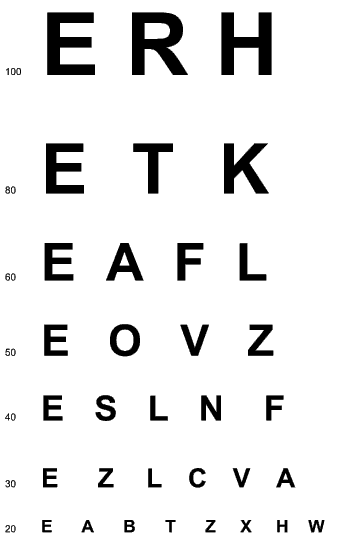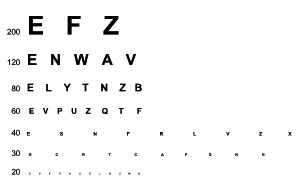



 |
  |

|
|
The E-Wink Chart 1) Print the following Chart and hang it on a well lighted wall.  2) Stand 10 feet back from the chart. At this distance the top E R H line is 20/100. The bottom E A B T Z X H W line is 20/20. 3) Take off your glasses. How does the chart look? If you wear stronger glasses, it may appear as if you are looking through a fog; the larger letters are blurred and the smaller letters are unrecognizable blobs of faded ink. Nothing appears really clear. If your glasses are weaker, the top lines may have appeared fairly clear and the lower lines blurry. If your glasses are very strong, you might have had difficulty making out any of the letters. If so, move closer to the chart until you can barely make out the top two lines. 3A) If you are past the age of forty and your problem is with seeing up close, instead of using the Far E- Wink Chart print out the following Near E-Wink Chart and hold it at 16 inches (or farther if necessary).  4) Using whichever chart applies, find the smallest line that you can barely see. Gently, close your eyes and picture the letter E in that line in you mind. Picture the E as black and clear as possible. Do not squeeze your eyes shut! Relax. 5) Pop your eyes wide open. By “popping your eyes wide open,”we mean exactly that. Don't gently open them. Don't open them just a little so that you can squint to see the print. Pop your eyes so wide that it feels as if you are throwing them across the room (or for the near chart pulling them into your head). Lift your eyebrows to help out. Once you've popped you eyes open, don't blink. Continue holding them open for at least fifteen seconds while you wait for the E to become as clear as it was in your mind. 6) Repeat this process until you see some improvement in the clarity of the E.
When working this exercise, some will get a “flash of clarity,” in which the E or the whole line comes into clear view for an instant and then blurs again almost before the letters can be read. This is a good start. Others will not only get the flash of clarity but maintain that clarity until they blink. This is better yet. Those who can achieve a flash of clarity on this sample exercise, are good candidates for at least becoming less dependent on glasses. For a variety of other sample exercises click on VISUAL FITNESS by David Cook. Or, if you are really serious about better eyesight without glasses, click on Make Appointment and schedule an exam and consultation for a program tailored to your personal needs. |
||||
|
|||||